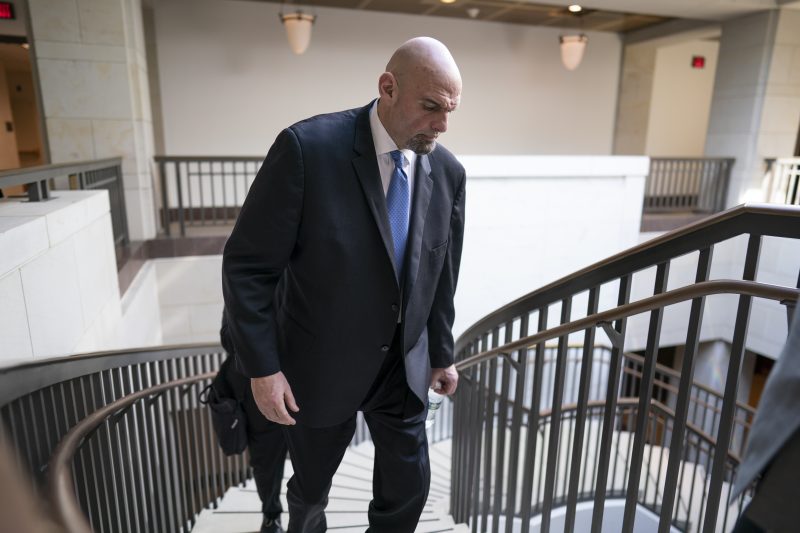Sen. John Fetterman’s hospitalization for depression is most likely to be short and successful, more a reset during a difficult period than a life-altering, career-threatening event, according to mental health authorities, other stroke survivors, academic research and people on Capitol Hill.
Despite lingering misconceptions about the gravity of hospitalization for acute depression, it is mainly a safe, speedy way to address a crisis. The vast majority of people resume the lives they led previously, though they may need ongoing outpatient care.
“The hospitalization doesn’t necessarily say anything about his future status,” said Will Cronenwett, chief of general psychiatry at Northwestern University’s Feinberg School of Medicine. “Hospitalization is often the thing to do to recover quickly. A hospitalization, rather than ending anyone’s career, enables them to regain lost function.”
Data show Fetterman’s chances of full recovery at 70 to 90 percent, said Joshua Gordon, director of the National Institute of Mental Health. That doesn’t mean he won’t need to stay on medication or continue therapy afterward, but in all likelihood, he will find relief from his symptoms of depression and return to normal functioning.
“Many people are able to stop medications and maintain wellness,” he said.
Fetterman (D-Pa.), 53, flipped a Republican Senate seat in November despite suffering a near-fatal stroke in May. On Thursday, he checked himself into Walter Reed National Military Medical Center for treatment of clinical depression. He had just returned to Congress on Monday, after being hospitalized last week for complaints of lightheadedness. Doctors ruled out a second stroke.
Fetterman still suffers from an auditory processing problem that makes it difficult for him to hear and pick up words, especially against background noise.
A senior Fetterman aide, who spoke on the condition of anonymity to discuss private details of the senator’s circumstances, said Fetterman could be hospitalized for several weeks although there is no clear timeline.
The aide said Fetterman’s lightheaded spell last week was likely caused by malnourishment and dehydration. Only in retrospect did aides come to understand that not eating or drinking is a common side-effect of depression.
The aide said Fetterman was “deeply not himself” in the days that followed and after consultation with the attending physician of Congress, Brian P. Monahan, decided he needed to check himself into the hospital.
About a third of stroke survivors develop depressive symptoms, including sadness, loss of appetite, low energy and social withdrawal, say experts, although just a small fraction of them are hospitalized.
Gordon said the organic component of post-stroke depression cannot be overlooked — a stroke, after all, is an injury to the brain.
“There are studies that show that compared to all other forms of depression, stroke-induced depression tends to be more severe,” he said.
Fetterman’s admission that he needed mental health care has been greeted largely with expressions of sympathy and encouragement from both sides of the aisle, a signal that stigma around such issues has declined substantially.
“Millions of people struggle with depression every day, often in private,” President Biden tweeted Friday. “Getting the care you need is brave and important. We’re grateful to you for leading by example.”
Sen. Ted Cruz (R-Tex.) whose wife publicly disclosed her depression during the 2016 presidential campaign, said Thursday on Twitter: “Heidi & I are lifting John up in prayer. Mental illness is real & serious, and I hope that he gets the care he needs.”
On Friday, Fetterman’s campaign team sent an email to supporters asking for donations to the National Alliance on Mental Illness and the Pennsylvania Mental Health Consumers’ Association. They promised that 100 percent of their contributions will go to the groups.
Experts say the decision about hospitalizing someone with clinical depression is often based on the severity and duration of symptoms, insurance coverage and whether they are a danger to themselves.
Once there, they are likely to be treated with medication, talk therapy and support, just as many outpatients are. The hospital environment makes that safer and quicker, because psychiatrists, psychologists, nurses and others are there to monitor side-effects, adjust medications and deliver talk therapy more frequently than someone would get otherwise. They can also be more aggressive with medications.
Cronenwett said one major goal of therapy in the hospital is to help a patient develop coping skills and resilience by challenging feelings of hopelessness that accompany depression. Feeling trapped, with no way out, is a hallmark of the disease, he said.
Doctors also will focus on teaching patients to get their sleep, reduce stress and resume activities and interests that promote wellness, he said. The immediate goal, he said, is to get the patient home.
“We as physicians want our patients to be out of the hospital and back in their own contexts as soon as possible,” Cronenwett said, “because it feels good when you can sleep in your own bed and be with your loved ones.”
A positive sign for Fetterman is his agreement that he needs inpatient care, said E. Alison Holman, a professor of nursing and psychological science at the University of California at Irvine. People in the grip of severe depression often lack that insight, she said.
“The fact that he checked himself in is evidence that is not the case for him,” she said.
Several stroke survivors described their own debilitating depressions following their physical losses — and mental recoveries alongside the physical ones.
Dennis Opalka, a Kansas City radio personality known as Dennis St. John, spent 18 months just progressing from a wheelchair to a cane after his stroke.
In an ambulance after a fall walking a few steps in a rehabilitation hospital, Opalka said, “I started regretting that I had lived through the stroke … When you start having thoughts like that, you are getting pretty dark.”
Counseling while getting physical therapy helped him begin to find his way.
“The first sessions, I b—-ed and moaned,” he said. “After two or three sessions, you start mending yourself. That felt good. I was working toward something, rather than trying to get away from something … working toward walking with a cane.”
Stroke survivor Lee Stroy of Stafford, Va., said his own journey back from depression was gradual, after suffering three strokes around Christmas in 2014.
“That led to a major depression,” Stroy said. He was 38 and “that guy walking around with a cane. I couldn’t drive. I couldn’t be around my children” because loud noises caused migraines. “Sometimes, it’s hard to stop that train from going to negative town.”
His wife talked him into seeing a psychiatrist and he was put on an antidepressant medications. “It’s not just one pill and one therapy session,” Stroy said. “It’s a lifestyle commitment.”
Now, he works full time again as a basketball coach at Stafford’s Brooke Point High School and is training to become a guidance counselor. Rid of a cane, he walks with a limp and has taught himself, “Well everybody’s got their own problems.”
His strokes, he said, have “allowed me to see life from a different perspective.”



























